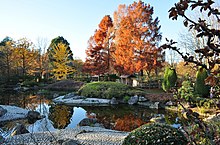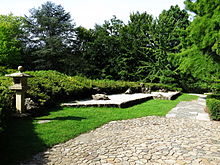Japanese Garden (Bonn)
The Japanese Garden within Bonn's Rheinauenpark was opened on April 27, 1979 as part of the Federal Garden Show .
description
The Japanese garden was created in the so-called Tsukiyama Sensai style, in which a lake, an island (called Nakshima in Japanese) and a small hill are the essential elements.
However, a pure meditation garden in the style of the old gardens of Kyoto was abandoned and a garden with a circular path, as in the Edo period , was created instead . In one part, a so-called Kare-San-Sui -garden (dry garden) was built, as was common in the Muromachi period , and individual parts of a tea garden were taken over.
As a Japanese convertible garden, it is relatively small compared to the water surface, which can only be explained by the love of the Japanese for water. The waterfall is therefore an essential component.
Further components are the 13-tier pagoda and the stone lanterns in different designs and meanings. Such pagodas, which were set up in temples in the Nara period and had a Buddhist significance, have no longer had any religious significance since the Edo period. They are just gems in gardens.
Two main techniques were used in the design of the garden. On the one hand, the surrounding landscape was included (referred to in Japanese as the Shakkei technique), and on the other hand, the garden was laid out in such a way that you can only see the water surface and the whole of the garden once you have stepped into the complex.
The garden is separated from the Rheinauenpark by a fence.
Components of the garden
- goal
- Stone lanterns in different designs
- Paved path
- Rock garden
- Artificial hill
- Room (machiai)
- Fountain
- arbor
- Torrent and waterfall
- 13-tier pagoda
Explanation of the garden
The garden is entered through the gate built in the tea ceremony style and should be entered counterclockwise.
Immediately after entering, the view falls on a heaped hill (Tsukiyama) and on a stone lantern (Nishinoya). The hill initially hides the actual shape of the garden in order to increase the tension on it. There is a commemorative plaque on the stone lantern reminding of the Federal Garden Show.
If you turn to the right and follow the mosaic-shaped path paved with long, narrow stones (called Nobedun in Japanese tea garden style), you will reach a small wooden hut with a replica fountain (Izutsu).
There is a Kare Sansui style dry garden on the left side of the path. The wooden hut, Machiai, is a waiting room where the visitor gets in the mood for the upcoming tea ceremony.
The path now leads over a wooden bridge to a small island, from which the entire garden and lake can be seen for the first time. There is another stone lantern (yukimi) on the island. Here the visitor learns what is meant by the Shakkei technique, since for the first time the view also falls on the Siebengebirge, which gives the garden size and breadth.
The path now leads over a second bridge to the Azumaya, a hexagonal copper-roofed wooden arbor in the style of a tea ceremony. From the open space in front of the arbor, which is used to prepare for a tea ceremony, there is a view of a small waterfall including a sandbank made of white granite stones on which the pagoda stands. The 500 tons of stones for the sandbank were selected in the mountains of Hanamaki in Iwate Prefecture and transported to Germany.
The path continues up the hill to the source of the torrent. The creek is crossed via stepping stones, called Sawatari. The view falls on some rapids and the large waterfall. Following the path, a viewpoint is reached from which the entire garden can be seen again. The path leads past the pagoda and a stone lantern (oribe), which is supposed to add an artificial element to the landscape, now back to the entrance.
Web links
Individual evidence
- Japanese Garden - Federal Garden Show 1979, published by the Japanese Embassy in the Federal Republic of Germany
Coordinates: 50 ° 42 ′ 46.6 ″ N , 7 ° 8 ′ 10.7 ″ E






